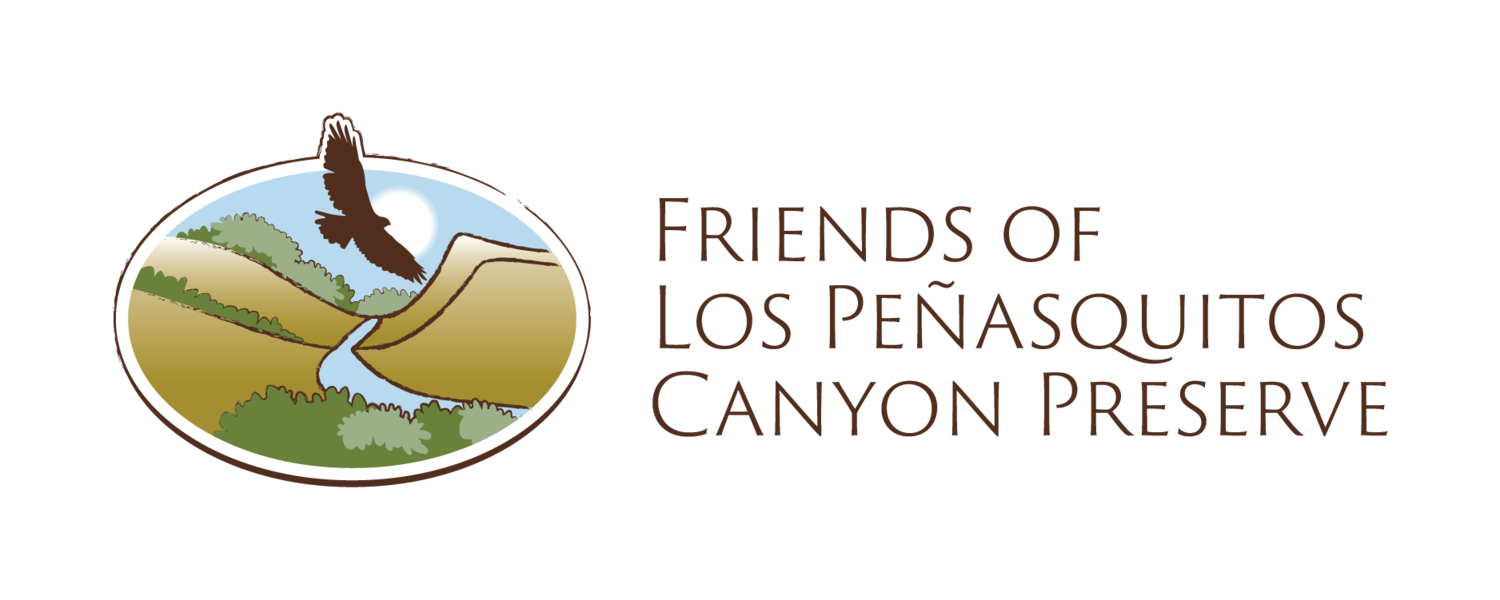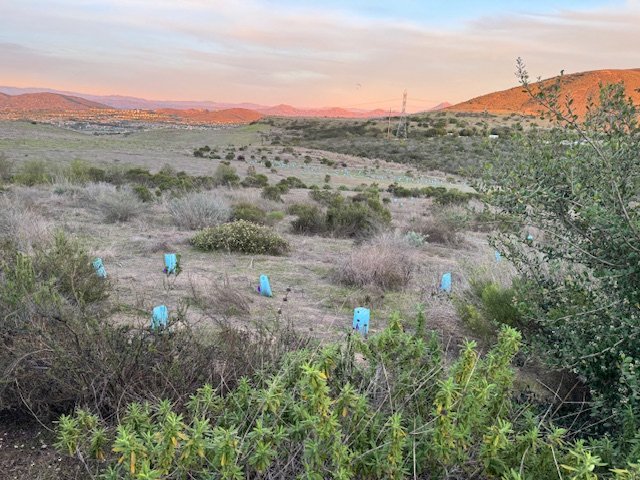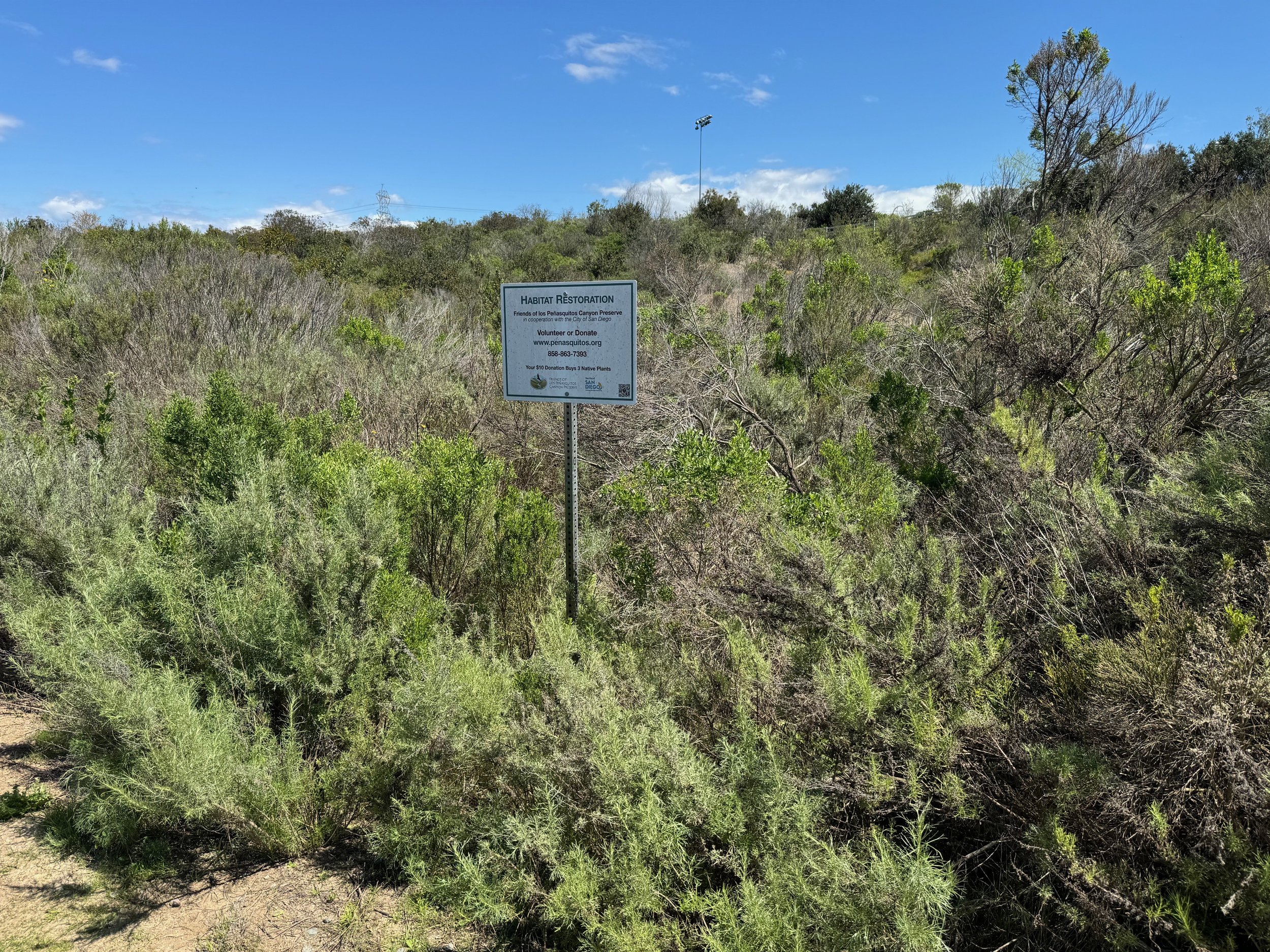What did the Friends of Los Peñasquitos Canyon Preserve do in 2023?
By Beth Mather
Every year the Friends board prepares a report for San Diego City detailing our activities in their Preserves and Open Space. We thought that our loyal supporters would be interested in this information as well.
Restoration Projects
In the last few years our major efforts have been in restoration. In 2023 we worked on 3 major projects. One of those projects has been ongoing for the last 10 years. This is the Santa Luz Grasslands in Black Mountain and Santa Luz Open Space. The project started as a small restoration just north of the Black Mountain Ranch Community Park. Over the years, we have expanded it to many acres. The goal is to convert fields of artichokes, mustards and non-native annual grasses into diverse, healthy coastal sage shrub and grasslands habitats. We have made considerable progress over the years. This year we held 25 volunteer work parties. These events are held every 2nd Sunday and draw from many different groups in the community including girl and boy scout troops, high school clubs and individual students, military personal, companies, interested residents of our area as well as people from more distant parts of San Diego. At these work parties, we plant a variety of native plants believed to have occupied this area in the past, we weed, and then we water new plantings throughout the summer and fall until the new plants are established. In 2023 our volunteers contributed about 554 hours of time to this project. If you haven’t seen this project, we invite you to take a walk from the north end of Black Mountain Ranch Community Park. As you walk the dirt road that circles around the outside of the park, you will see areas that have been restored as well as the areas we are still in the process of restoring. A huge thanks to all of you who have participated in this project over the years. Your work speaks for itself!
The Friends initiated two new restoration projects in 2023 in the Los Penasquitos Canyon Preserve. The first is in a small canyon called Darkwood Canyon that connects with the main Penasquitos canyon. It extends north from Penasquitos Creek near Park Village Elementary towards I-56 and beyond. The city park rangers, Gina Washington and Melanie Fontana, considered this canyon a high priority for restoration. In addition to feeding into the main canyon, the San Diego Tracking Team identified this canyon as a wildlife corridor.
Although the canyon has a large amount of native plant communities such as chaparral, coastal sage shrub, grassland and riparian communities, it also has a significant number of invasive plants. These invasive plants will continue to spread if they are not eliminated. Some of those invasive plants in Darkwood Canyon that you may be familiar with include pampas grass, artichokes, fennel, tamarisk, non-native palms, peppers trees, as well as many mustards, thistles and other weeds.
This project was a major undertaking, and we were pleased that Protect Our Preserves, Inc. (POPs) agreed to partner with us. We would like to extend our appreciation to the POPs board who awarded us a grant to help us fund this large project.
We hired a city approved contractor to begin this work in February 2023. Significant progress was made in 2023. Hundreds of artichokes and pampas grass were treated along with large number of mustards, thistles, and other weeds. Our contractor performed 250 hours of work and volunteers contributed an additional 82. This project is ongoing. We expect to continue working Darkwood Canyon for several more years as we remove more plants and deplete the weed seed bank.
The second project that we initiated in the Los Penasquitos Canyon Preserve is at the west end of the canyon in an area that has been called Harrier Hill, so named because harriers used to nest in this area. It has ceased being a good nesting site because of a change of habitat. The native grassland has been replaced by dense non-native grasses, artichoke, fennel and mustard.
Once again, the POPs board kindly supported our restoration effort in this area with a grant.
Significant progress was made in 2023. Plans for 2024 include follow up treatment as well as planting native grasses and forbs to restore the nesting site.
The Friends continued their work this year to help improve the habitat on the west and north sides of Black Mountain. Artichoke, fennel, mustard, garland chrysanthemum, thistles, and stinkwort have been targeted in some of the high priority areas along the west side of Black Mountain Open Space. Invasive plants in the Miner’s Ridge Loop and the Glider Port areas have also been removed.
Endangered Plants
There are a number of endangered plants in our Preserves. The Friends continue to be involved in trying to improve their survival. One of those plants is Brodiaea filafolia, the narrow leaf brodiaea. In addition to helping city personnel with the surveys of these plants, we continue doing invasive weed control in the area where the plants are growing.
Another endangered plant is Monardella viminea or willowy monardella. The Friend’s volunteers made several visits to control weeds near the Lopez Canyon populations of these plants.
Public Hikes
Another major activity of the Friends is to lead interpretive hikes. The Friends typically lead weekend hikes open to the public. We led or sponsored hikes in PQ Canyon, Carmel Mountain, Del Mar Mesa, Black Mountain, and 4-S Ranch. Hikes include bird watching, history hikes, vernal pool hikes, medicinal plant hikes, flower hikes, and general nature hikes. The total number of hikes for 2023 was 32 with approximately 358 participants, 8 hike leaders and about 122 volunteer hours.
Gold Spotted Oak Borers (GSOB)
A limited survey was done this year of the Coast live oaks. The Friends volunteers guided the contractor spray crew in the Preserve and other volunteers helped monitor entrances to the canyon. The Friends obtained a grant from POPs to pay for one half of the treatment and the Friends paid for the other half from our funds.
Outreach Activities
The Friends participated in 4 outreach events in 2023 with educational displays and materials at the Mira Mesa and Rancho Peñasquitos Street Fairs, as well as Arch (Archaeology) in the Park and the San Diego County’s 150-year celebration at the Peñasquitos ranch house. Seven different volunteers contributed about 90 hours.
The Friends maintain a website and use other social outreach to inform the public of our activities as well as promoting an interest in the nature found in our Open Spaces. Most of you are probably familiar with the website, but if not, please take a look. In addition to great photos, we post our work parties, our hikes, as well as the work parties sponsored by the rangers.
Here is a summary of the volunteer hours spent on these activities.
We couldn’t have done this work without all our supporters. Our thanks for your support this last year as well as for all the years past.



